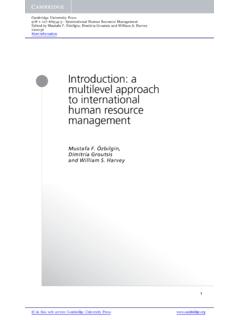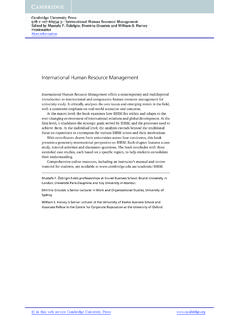Transcription of Unequal, Unfair, Ineffective and Inefficient Gender ...
1 Unequal, Unfair, Ineffective and Inefficient Gender Inequity in Health: Why it exists and how we can change it Final Report to the WHO Commission on Social Determinants of Health September 2007 Women and Gender Equity Knowledge Network Submitted by Gita Sen and Piroska stlin Co-coordinators of the WGEKN1 Report writing team Gita Sen, Piroska stlin, Asha George 1 We are very grateful to the members and corresponding members of the WGEKN, and the authors of background papers for their willingness to write, read, comment and send material.
2 Special thanks are due to Linda Rydberg and Priya Patel for their cheerful and competent support at the different stages of this report. We would also like to thank Beena Varghese for her inputs to the report. ii MembersRebecca Cook Claudia Garcia Moreno Adrienne Germain Veloshnee Govender Caren Grown Afua Hesse Helen Keleher Yunguo LIU Piroska stlin (Coordinator) Rosalind Petchesky Silvina Ramos Sundari Ravindran Alex Scott-Samuel Gita Sen (Coordinator) Hilary Standing Debora Tajer Sally Theobald Huda Zurayk Corresponding members Pat Armstrong Jill Astbury Gary Barker Anjana Bhushan Mabel Bianco Mary Anne Burke James Dwyer Margrit Eichler Sahar El- Sheneity Alessandra Fantini Elsa G mez Ana Cristina Gonz lez V lez Anne Hammarstr m Amparo Hern ndez-Bello Nduku Kilonzo Jennifer Klot Gunilla Krantz Rally Macintyre Peggy Maguire Mary Manandhar Nomafrench Mbombo Geeta Rao Gupta Sunanda Ray Marta Rondon Hania Sholkamy Erna Surjadi Wilfreda Thurston Joanna Vogel Isabel Yordi Aguirre Authors of background papersKarina Batthy ny Sonia Correa Lucinda Franklin
3 Asha George Veloshnee Govender Aditi Iyer Helen Keleher Aarti Kelkar-Khambete Melissa Laurie Ranjani Murthy Piroska stlin Loveday Penn-Kekana Rosalind Petchesky Sundari Ravindran Gita Sen Rachel Snow Reviewers of background papers Gary Barker Anjana Bhushan Lesley Doyal James Dwyer Sahar El-Sheneity Alexandra Fantini Ana Cristina Gonz lez V lez Amparo Hern ndez Bello Peggy Maguire Mary Manandhar Piroska stlin Martha Rondon Gabrielle Ross Gita Sen Hania Sholkamy Wilfreda Thurston Joanna Vogel Huda Zurayk Other contributors Tanja Houweling Gabrielle Ross Marion Stevens G ran Tomson Susan Watts iii Acknowledgements We express our gratitude for the collective patience and expertise generously offered by Knowledge Network Members, Corresponding Members, Authors of background papers and case studies involved in this report, and their Reviewers.
4 We are also indebted to Commissioners Hoda Rashad, Monique Begin, Mirai Chatterjee, Ndioro Ndiaye and Denny V ger for their guidance and support, and to Commissioner Rashad especially for hosting the Cairo meeting of the Knowledge Network. Our focal points, Gabrielle Ross from WHO and Tanja Houweling from University College London have been very supportive. Special thanks to Dorrit Alopaeus-St hl at the Ministry of Foreign Affairs in Sweden for her support and the external reviewers of the draft version of this report for their valuable comments. We thank also our colleagues in the Globalisation and Health Systems Knowledge Networks, who have been particularly helpful in sharing ideas and evidence.
5 We thank also our institutions, the Indian Institute of Management Bangalore and the Karolinska Institutet in Sweden for giving home to the organizational hubs of the Knowledge Network. Disclaimer This work was made possible through funding provided by the World Health Organization (WHO), the Swedish National Institute of Public Health (SNIPH) and the Open Society Institute (OSI) and undertaken as work for the Women and Gender Equity Knowledge Network established as part of the WHO Commission on the Social Determinants of Health. The views presented in this work/publication/report are those of the authors and do not necessarily represent the decisions, policy or views of WHO or Commissioners.
6 Iv TABLE OF CONTENTS POLICY EXECUTIVE I. BASIC BEYOND MOTHERHOOD AND APPLE II. THE EVIDENCE BASE OF THE III. DIAGNOSIS: SO WHAT S THE PROBLEM?..6 Gender , WOMEN, EQUITY AND INTERSECTING SOCIAL SOCIAL STRATIFIERS AND STRUCTURAL PROCESSES HOW DO THEY INTERACT?..9 CAUSAL PATHWAYS AND A IV. GENDERED STRUCTURAL WHAT DO WE KNOW?..11 Gender as a social Gendered structural Women s movements and human PROMOTING HUMAN RIGHTS AND STRENGTHENING WOMEN S Deepening the normative framework and realizing human Cushioning the shock absorbers ..24 Expanding women s capabilities focus on V.
7 NORMS, VALUES AND WHAT DO WE KNOW?..28 How do norms work?..28 Gendered norms affecting CHALLENGING Gender STEREOTYPES AND HOW THEY AFFECT Create formal agreements, codes and laws to change norms that violate women s human rights, and implement/enforce Adopting multi-level strategies to changes norms including support for women s Working with boys and men for male VI. DIFFERENCES IN EXPOSURE AND WHAT DO WE KNOW?..42 Mapping male-female differences in Understanding male-female differences in Exposure and vulnerability due to both sex and Exposure and vulnerability due primarily to REDUCING THE HEALTH RISKS OF BEING WOMEN AND Meeting differential health Tackling social Tackling the structural dimensions of individual risk Empowering individuals and communities for positive VII.
8 THE GENDERED POLITICS OF HEALTH CARE WHAT DO WE KNOW?..60 Women as consumers of health Women as health v Accountability mechanisms for improved health CHANGING HOW WE CARE AND How to raise awareness and improve acknowledgment of women s health How to improve women s access to health HOW TO STRENGTHEN ACCOUNTABILITY OF HEALTH SYSTEMS TO CITIZENS?..75 VIII. HEALTH WHAT DO WE KNOW?..79 Gender imbalances in research Gender imbalances in the research CHANGING WHAT WE Prerequisites for conducting gendered health What gets measured is what gets done data and IX.
9 REMOVING ORGANISATIONAL MAINSTREAMING AND CATALYSING Gender EQUITY IN Mainstreaming for Gender equality and Gender mainstreaming in Empowering women for better X. THE WAY FORWARD GETTING THERE FROM ANNEX 1. LIST OF BACKGROUND ANNEX 2: CASE 1. The impact on women of changes in personal status law in 2. What was done in South Africa and what can be learnt from ANNEX 3. AGE ADJUSTED AND NON-WEIGHTED 2002 DALYS BY vi Acronyms AIDS Acquired Immune Deficiency Syndrome ARROW Asian-Pacific Resources and Research Centre for Women ART Anti-retroviral therapy AWID Association of Women s Rights in Development CASSA Campaign against Sex Selective Abortion CHWs Community health workers CSDH Commission on the Social Determinants of Health DALY Disability Adjusted Life Years DHS Demographic and Health Survey EU European Union FGM Female Genital Mutilation GBV Gender Based
10 Violence GDP Gross Domestic Product GHI Global Health Initiative HDI Human Development Index HIV Human Immunodeficiency Virus HSKN Health Systems Knowledge Network ICESCR international Covenant on Economic, Social and Cultural Rights ICPD international Conference on Population Development IDP Internally Displaced Person IGWG Inter-Agency Gender Working Group IMR Infant Mortality Rate IPV Inactivated Polio Vaccine KN Knowledge Network LGBT Lesbian, Gay, Bisexual and Transgender LE Life Expectancy LMICs Low and middle-income countries MDG Millennium Development Goal MMR Maternal Mortality Rate MNCH Maternal.











